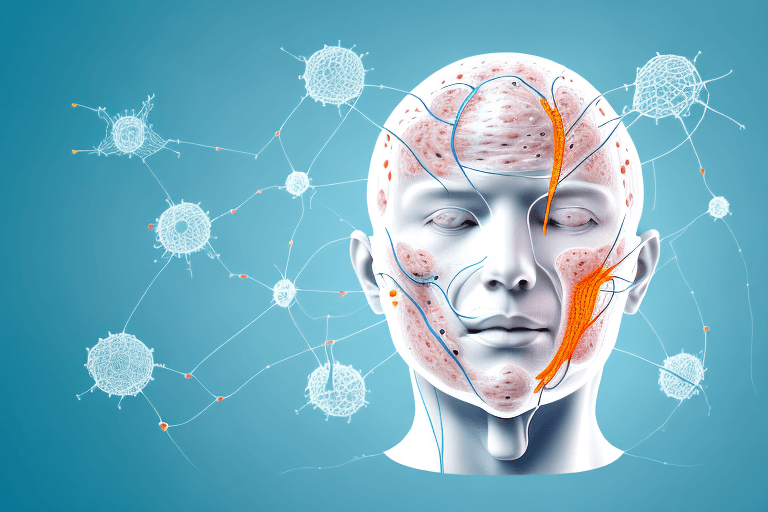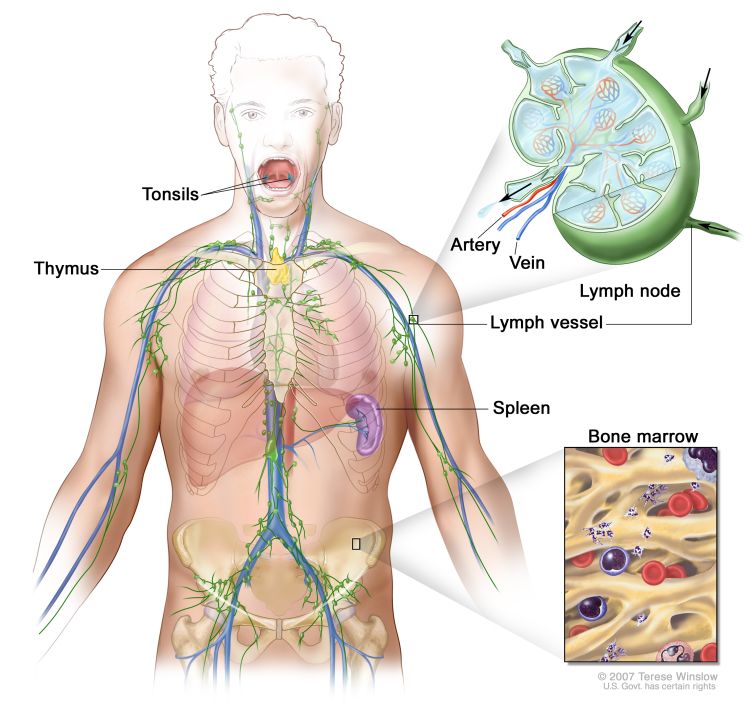Lymph Nodes in the Face: Anatomy, Function & Common Conditions
The lymphatic system is an essential component of the immune system. It is responsible for filtering and removing harmful substances from the body, as well as fighting off infections. One of the key structures in the lymphatic system is the lymph nodes, small bean-shaped organs found throughout the body. In this article, we will focus on the lymph nodes in the face, exploring their anatomy, function, common conditions, diagnosis, and treatment options.
Understanding the Structure and Functions of Lymph Nodes
Lymph nodes are essential components of the immune system that play a crucial role in protecting the body from infections and diseases. These small, bean-shaped structures are distributed throughout the body and act as filters for lymph fluid, which carries immune cells and other substances through the body’s tissues.
- Lymph nodes consist of two types of tissue: connective tissue and lymphoid tissue.
- Connective tissue provides support and structure for the lymph node.
- Lymphoid tissue is responsible for the immune functions of the lymph node.
- Lymphatic vessels enter and exit the lymph node at specific points called the hilum.
There are several distinct areas within a lymph node, including the cortex, medulla, and paracortex, each with its own specialized structures and cells. The cortex of the lymph node is composed of B-cell follicles, which are concentrated in germinal centers. These follicles produce and secrete antibodies, specialized proteins that target and neutralize foreign pathogens. The medulla of the lymph node contains plasma cells, which secrete large quantities of antibodies into the bloodstream. The paracortex of the lymph node contains T-cell zones, where T-lymphocytes are activated and stimulated to mount an immune response to specific pathogens.
Enhanced Functionality of Lymph Nodes: Guardians of Immune Defense
The lymph nodes are an essential component of the immune system, and they play a crucial role in protecting the body from infections and diseases. The lymphoid tissue within the nodes contains specialized cells, including lymphocytes and macrophages that help to identify and destroy foreign invaders.
- B-cell follicles in the cortex of lymph nodes produce and secrete antibodies.
- Antibodies are specialized proteins that target and neutralize foreign pathogens.
- Antibodies bind to the surface of invading pathogens.
- Binding of antibodies marks the pathogens for destruction by other immune cells.
The medulla of the lymph node contains plasma cells, which are specialized cells that secrete large quantities of antibodies into the bloodstream. These antibodies can help to prevent the spread of infection and can also provide long-term immunity to specific pathogens.
The paracortex of the lymph node contains T-cell zones, where T-lymphocytes are activated and stimulated to mount an immune response to specific pathogens. These T-cells can recognize and destroy infected cells, helping to prevent the spread of infection throughout the body.
Distribution of Lymph Nodes in the Face: Protecting Facial Health and Immunity
The face has an extensive network of lymph nodes, which are organized into clusters or chains. These lymph nodes are essential for protecting the facial region from infections and diseases.
The submandibular lymph nodes are located just below the jawline and are responsible for draining lymph fluid from the tongue, mouth, and lips. The submental lymph nodes are situated under the chin and drain lymph fluid from the chin and lower lip. The parotid lymph nodes are located in the salivary gland near the ear and drain lymph fluid from the scalp, face, and neck. The retroauricular lymph nodes are located behind the ear and drain lymph fluid from the scalp and ear. The preauricular lymph nodes are located in front of the ear and drain lymph fluid from the eyelids and conjunctiva.
Overall, the lymph nodes in the face play a crucial role in protecting the facial region from infections and diseases. By filtering lymph fluid and identifying and destroying foreign invaders, these lymph nodes help to keep the face healthy and free from infection.
Lymph Nodes in the Face: Key Players in Immune Defense
The lymph nodes in the face, like all lymph nodes, are crucial for the immune system’s ability to fight off infections. When a pathogen enters the body, antigens from the pathogen are carried to the lymph nodes by the lymphatic vessels. The antigens are then presented to the immune cells in the node, which activate and start to produce antibodies or T-cells specific to the pathogen. Once produced, these immune cells are released into the bloodstream to attack and eliminate the pathogens.
Lymph Node Activation: Responses to Infection, Inflammation, and Vaccination
Lymph nodes can become activated due to infections, inflammation, or malignancies. An activated lymph node may become swollen and tender to the touch, indicating increased activity and immune function. However, not all enlarged lymph nodes are activated, and some may be due to other causes, such as cancer. It’s essential to seek medical attention if you notice any abnormal enlargement or swelling in the facial lymph nodes.
It’s important to note that lymph nodes can also become activated due to vaccines. When a vaccine is administered, it contains weakened or dead pathogens that stimulate the immune system to produce antibodies without causing disease. These antigens are carried to the lymph nodes, where they activate the immune cells to produce specific antibodies to fight off the pathogen in the future.
Lymphatic Drainage: Essential for Immunity and Health
The lymphatic system and lymph nodes play a critical role in maintaining fluid balance and fighting infections. Lymphatic drainage is the process by which lymph fluid is moved from the tissues to the lymph nodes, where it can be filtered and purified. The lymphatic system is also responsible for removing waste products and excess fluid from the body. A healthy lymphatic system is vital for strong immune function and overall health.
Effects of compromised lymphatic system:
- Variety of health issues can arise when the lymphatic system is compromised.
- Lymphedema: Excess fluid accumulation in tissues causing swelling and discomfort.
- Lymphedema can occur when lymph nodes are removed or damaged, like during cancer treatment.
- Infections can spread through the compromised lymphatic system.
- Lymphatic system compromise can contribute to sepsis development.
There are several ways to support the health of the lymphatic system. Exercise, massage, and compression garments can all help improve lymphatic drainage and reduce swelling. Eating a healthy diet rich in fruits and vegetables can also support immune function and overall health.
In conclusion, the lymph nodes in the face play a crucial role in the immune system’s ability to fight off infections. Understanding how the lymphatic system works and how to support its health is essential for maintaining strong immunity and overall health.
Understanding the Impact on Facial Lymphatic System
The lymphatic system is a vital part of the body’s immune system, responsible for filtering and removing waste and toxins from the body. Lymph nodes are small, bean-shaped structures located throughout the body, including in the face and neck. The facial lymph nodes are responsible for draining lymphatic fluid from the head and face, and are an important part of the body’s defense against infection and disease.
There are several common conditions that can affect the facial lymph nodes, including lymphadenitis, lymphadenopathy, and lymphoma.
Lymphadenitis
Lymphadenitis is an infection of the lymph nodes that can result in inflammation, swelling, and tenderness. The infection is usually caused by bacteria, and can occur in any part of the body, including the face and neck. Common symptoms of lymphadenitis include fever, chills, fatigue, and muscle aches, as well as redness and swelling around the affected lymph nodes. In severe cases, the infection can spread to other parts of the body, leading to complications such as sepsis.
Treatment for lymphadenitis typically involves antibiotics and supportive care, such as pain relief and rest. In some cases, surgical drainage of the affected lymph nodes may be necessary to remove pus and other infectious material.
Lymphadenopathy
Lymphadenopathy is a term used to describe the enlargement of one or more lymph nodes. It can be caused by a variety of factors, including infection, inflammation, and cancer. In the face and neck, lymphadenopathy is often caused by infections of the upper respiratory tract, such as the common cold or flu.
The diagnosis and treatment of lymphadenopathy depend on the underlying cause of the condition. In cases where the enlargement is due to infection, treatment may involve antibiotics or antiviral medications. In cases where the enlargement is due to cancer, treatment may involve surgery, radiation therapy, or chemotherapy.
Lymphoma
Lymphoma is a type of cancer that affects the lymph nodes and lymphatic system. It can result in significant swelling and enlargement of the affected nodes, as well as other symptoms such as fever, night sweats, and weight loss. There are two main types of lymphoma: Hodgkin lymphoma and non-Hodgkin lymphoma.
The diagnosis and treatment of lymphoma depend on the type and stage of the cancer. Treatment for lymphoma typically involves chemotherapy, radiation therapy, or a combination of both. In some cases, stem cell transplantation may also be necessary.
It is important to seek medical attention if you experience any symptoms of lymphadenitis, lymphadenopathy, or lymphoma. Early diagnosis and treatment can help to prevent complications and improve outcomes.
Comprehensive Assessment and Diagnostic Procedures
Diagnosis of lymph node issues typically involves a thorough physical examination, as well as imaging tests and laboratory tests as needed. Your doctor may order blood tests, biopsies, or other imaging tests, such as ultrasound, to help diagnose the underlying cause of any lymph node issues.
Assessing Lymph Nodes and Tissue Health
During a physical examination, your doctor will evaluate the size, location, and consistency of any enlarged or swollen lymph nodes. They may also check for signs of infection or inflammation in the surrounding tissues.
Detailed Visualization of Lymph Nodes and Surrounding Tissues
Imaging techniques such as ultrasound, MRI, or CT scans can provide a detailed view of the lymph nodes and surrounding tissues. These tests can help identify any abnormalities or signs of disease.
Investigating Potential Cancer or Infections through Tissue Sampling and Diagnostic Tests
If there is a suspicion of cancer or another serious condition, your doctor may order a biopsy to sample the lymph node tissue for diagnosis. Laboratory tests, including blood tests and cultures, can also help diagnose infections or other underlying conditions.
Managing Lymph Node Conditions with Varied Strategies
Treatment options for lymph node conditions can vary depending on the underlying cause and severity of the condition. Some common treatment options include medications, surgical interventions, and alternative therapies.
Medications
For infections or inflammation of the lymph nodes, antibiotics or anti-inflammatory medications may be prescribed. Pain relief medications may also be used to manage discomfort caused by lymph node swelling or tenderness.
Surgical Interventions
In some cases, surgical removal of the affected lymph nodes may be necessary, especially if cancer is suspected. This procedure called a lymph node dissection, involves removing all or part of the nodes and is often followed by radiation or chemotherapy and careful monitoring.
Alternative Therapies
Alternative therapies such as dietary changes, herbal supplements, and massage may help support the lymphatic system and promote healing in some cases. However, it’s essential to speak to a healthcare professional before starting any alternative therapies.
Conclusion
Understanding the anatomy, function, and common conditions affecting the facial lymph nodes is crucial for maintaining good health and preventing serious illnesses. Early diagnosis and appropriate treatment of lymph node issues can help ensure the best possible outcomes and prevent the spread of disease to other parts of the body. If you have concerns about the health of your facial lymph nodes, make sure to speak to your doctor or healthcare professional for an accurate diagnosis and appropriate treatment plan.














